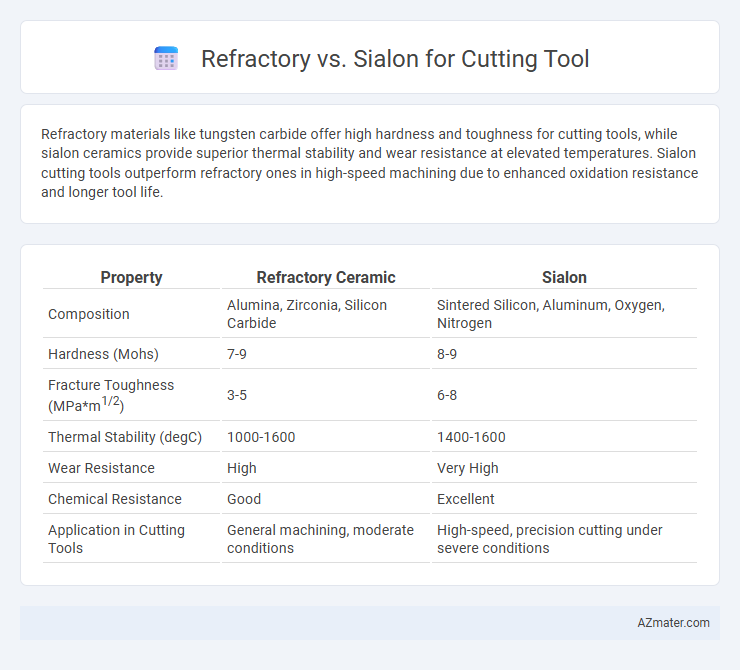Refractory materials like tungsten carbide offer high hardness and toughness for cutting tools, while sialon ceramics provide superior thermal stability and wear resistance at elevated temperatures. Sialon cutting tools outperform refractory ones in high-speed machining due to enhanced oxidation resistance and longer tool life.
Table of Comparison
| Property | Refractory Ceramic | Sialon |
|---|---|---|
| Composition | Alumina, Zirconia, Silicon Carbide | Sintered Silicon, Aluminum, Oxygen, Nitrogen |
| Hardness (Mohs) | 7-9 | 8-9 |
| Fracture Toughness (MPa*m1/2) | 3-5 | 6-8 |
| Thermal Stability (degC) | 1000-1600 | 1400-1600 |
| Wear Resistance | High | Very High |
| Chemical Resistance | Good | Excellent |
| Application in Cutting Tools | General machining, moderate conditions | High-speed, precision cutting under severe conditions |
Introduction to Cutting Tool Materials
Cutting tool materials require exceptional hardness, thermal stability, and wear resistance to withstand high-speed machining conditions. Refractory materials, such as tungsten carbide and ceramics, offer superior hardness and temperature resistance but may lack toughness. Sialon ceramics combine the strength and thermal shock resistance of silicon nitride with enhanced toughness, making them increasingly popular for high-performance cutting tool applications.
Overview of Refractory Materials
Refractory materials for cutting tools are engineered to maintain strength and hardness at high temperatures, enabling efficient machining in demanding industrial applications. These materials, such as tungsten carbide and ceramic composites, offer excellent wear resistance and thermal stability, critical for prolonging tool life and ensuring precise cutting performance. Comparatively, Sialon ceramics provide superior fracture toughness and oxidation resistance, though traditional refractory materials remain widely used due to their cost-effectiveness and established performance in heavy-duty cutting tasks.
What is Sialon?
Sialon is a type of advanced ceramic material composed primarily of silicon, aluminum, oxygen, and nitrogen, offering exceptional hardness, thermal stability, and wear resistance. Unlike traditional refractory materials used in cutting tools, Sialon provides superior fracture toughness and chemical inertness, making it ideal for high-speed machining and challenging cutting conditions. Its unique microstructure enhances tool life and performance, especially in applications involving hardened steels and superalloys.
Chemical Composition: Refractory vs Sialon
Refractory cutting tools primarily consist of high-density alumina (Al2O3) or zirconia (ZrO2) ceramics, offering superior hardness and thermal stability due to their oxide-based chemical composition. Sialon cutting tools, composed of silicon, aluminum, oxygen, and nitrogen, exhibit enhanced toughness and oxidation resistance because of their complex mixed ceramic-nitride structure. The chemical composition of Sialon enables better performance in aggressive cutting conditions compared to traditional refractory oxides.
Mechanical Properties Comparison
Refractory materials like tungsten carbide exhibit exceptional hardness and wear resistance but often lack the toughness and thermal shock resistance of Sialon ceramics, which combine silicon nitride with aluminum oxide to deliver superior fracture toughness and high-temperature stability. Sialon cutting tools provide enhanced mechanical properties such as improved flexural strength and fracture toughness, enabling longer tool life under high-stress machining conditions. The balance of hardness and toughness in Sialon materials makes them ideal for applications requiring durability and resistance to cracking, outperforming traditional refractory cutting tools in demanding environments.
Thermal Stability and Heat Resistance
Refractory materials like tungsten carbide exhibit high thermal stability but often lack the superior heat resistance seen in Sialon ceramics, which maintain structural integrity at temperatures exceeding 1400degC. Sialon's unique silicon-aluminum-oxynitride composition offers exceptional oxidation resistance and thermal shock resistance, making it ideal for high-speed cutting tools operating under extreme thermal conditions. The enhanced heat resistance of Sialon reduces tool wear and extends tool life compared to conventional refractory cutting tools.
Wear Resistance in Machining Applications
Refractory materials exhibit high hardness and thermal stability but generally fall short in wear resistance compared to Sialon ceramics, which offer exceptional toughness and durability under extreme machining conditions. Sialon cutting tools demonstrate superior resistance to abrasive wear and thermal degradation, resulting in prolonged tool life and consistent machining performance in high-speed and interrupted cutting operations. Enhanced microstructural integrity and optimized grain boundaries in Sialon contribute to its ability to maintain sharp cutting edges and reduce tool failure rates in manufacturing environments.
Cost Efficiency and Manufacturing Considerations
Sialon cutting tools offer superior cost efficiency compared to traditional refractory tools due to their enhanced wear resistance and longer tool life, which reduce replacement frequency and downtime. Manufacturing considerations favor Sialon as its advanced ceramic composition allows for precise machining and excellent thermal stability, leading to consistent performance in high-speed cutting applications. Refractory tools, while generally lower in initial cost, may incur higher long-term expenses due to shorter durability and more frequent maintenance requirements.
Best Applications: When to Use Refractory or Sialon
Refractory ceramics are ideal for cutting tools used in high-temperature, low-speed applications such as cast iron machining due to their excellent wear resistance and thermal stability. Sialon ceramics excel in high-speed machining and precision cutting of hardened steels, offering superior fracture toughness and thermal shock resistance. Selecting refractory or sialon depends on the specific cutting environment, with refractory suited for abrasive, low-speed tasks and sialon for high-speed, high-impact operations.
Future Trends in Cutting Tool Technologies
Sialon cutting tools exhibit superior wear resistance and thermal stability compared to traditional refractory materials, positioning them as a critical component in the evolution of high-performance machining. Emerging future trends emphasize the integration of Sialon-based composites to enhance tool life and precision in high-speed cutting applications. Advances in nanostructured coatings and additive manufacturing techniques further optimize the mechanical properties of Sialon tools, driving innovation in sustainable and cost-effective cutting technologies.

Infographic: Refractory vs Sialon for Cutting Tool
 azmater.com
azmater.com